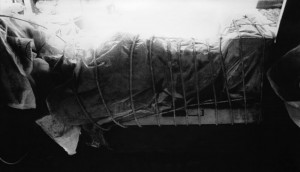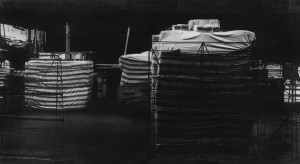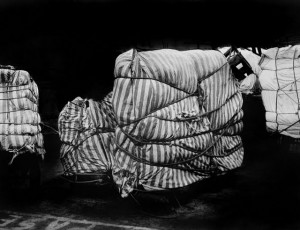At a time when so much photography is very big and beautiful but its main subject would seem to be virtuosity, it is exciting to come upon a body of work that conveys an urgent need to say something. Fernell Franco’s Amarrados (Bound) at the Americas Society through Dec. 12, 2009 clearly grew out of Franco’s necessity to tell a more complex story than allowed by his day job as a photojournalist for several Colombian newspapers.

Franco’s first New York exhibition, curated by Maria Iovino, consists of twenty large, grainy black and white photographs (all described as gelatin silver prints with chemical intervention and airbrush) and a number of studies which indicate just how much darkroom intervention occurred for each subject.

Franco’s job meant that his own work could only be done in the late afternoon or pre-dawn. The Amarrados series dates from the 1980s and was shot in Colombia and elsewhere in Latin America. On close viewing it becomes apparent that the images were taken in street markets at night, after the crowds had left. The vendors’ carts were secured with a motley assortment of tarps, fabric and ragged pieces of corrugated cardboard and bound crudely with rope: so much merchandise ready to be unwrapped another day, at perhaps another location.

But the first impact of the series is more powerful and more poetic. The bound, indeterminate forms in dark, unidentified spaces poignantly refer to the potential of their contents. Given the period and locations in which they were taken they inevitably evoke the voices and actions of people whose agency was held in check, often by violence, by ongoing conflicts and repressive regimes. The photographer said that only after seeing wrapped mummies in Egypt and then in Peru did he realize that his Amarrados series was about death and its unacknowledged presence.
On Thursday, Oct. 1 at 6:30 pm the Americas Society will host a panel discussion, Between Accuracy and Aesthetic; Documentary Photography, Photojournalism and Social Photographic Practices in the 1970s and 1980s with Sagrario Berti, Susan Meiselas, and Louis Roldán.





